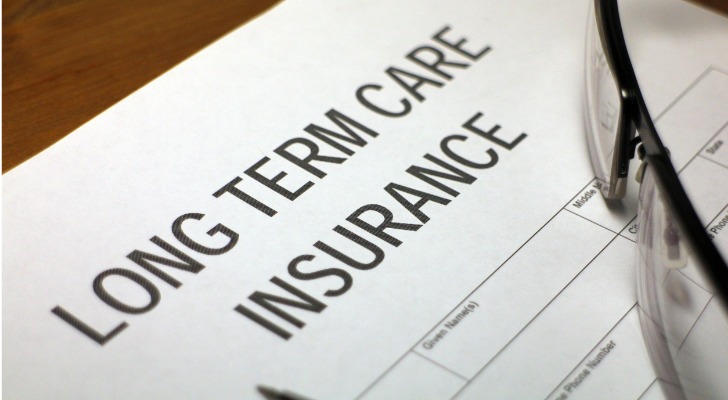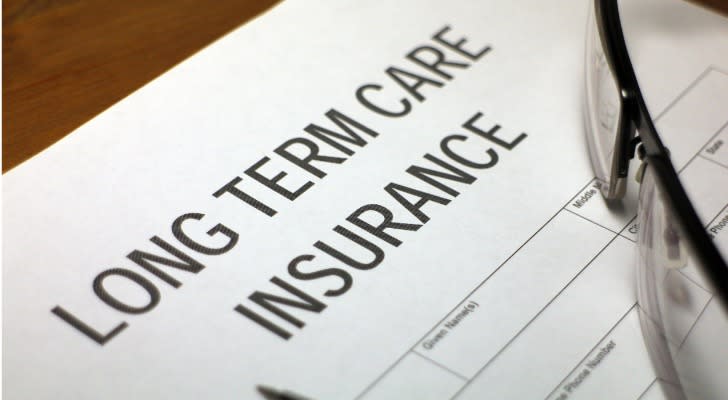CryptoCurrency
Bitcoin ETF options expected by Q1 2025: Bloomberg analyst


Options on Bitcoin ETFs could speed up adoption among financial advisers, James Seyffart said at Permissionless.
CryptoCurrency
Argentina overtakes Brazil in crypto inflows — Chainalysis


Argentina’s stablecoin market is one of the largest in the world in terms of share of stablecoin transactions, beating the global average by 17%.
CryptoCurrency
Trump crypto project proposes Aave link in governance proposal


The Donald Trump-backed crypto platform, World Liberty Financial, wants to run as an instance on the DeFi protocol Aave.
CryptoCurrency
I’m 68 with a $600 Monthly Long-Term Care Premium-Is This Too High?


SmartAsset and Yahoo Finance LLC may earn commission or revenue through links in the content below.
Imagine that you’re 68 years old and have a long-term care insurance policy in place that will help you pay for this all-important type of care later in life. You pay $600 per month in premiums and tell yourself it’s a good investment, considering how expensive long-term care can be.
Consider working with a financial advisor if you need additional help planning for long-term care and other needs you’ll have later in life.
The problem? Your premiums are well above the average monthly cost of long-term care coverage. Here’s what you should be thinking about if you’re interested in buying long-term care insurance or evaluating whether you’re paying too much for it.
What Is Long-Term Care Insurance?
Long-term care insurance helps pay for extended or residential treatment such as in-home care (like a home health aide) or residential/custodial care (such as a nursing home or assisted living).
Long-term care insurance generally doesn’t cover medical bills outside of the extended treatment itself. For example, if you stay in a nursing home and need to see the doctor, your long-term care insurance would pay for the nursing home while health insurance/Medicare would pay for the doctor’s appointment.
Health insurance and Medicare, on the other hand, don’t pay for residential care. This is what makes long-term care insurance so important for retirement planning. As the American Council on Aging found in 2021, staying in a nursing home can cost more than $100,000 per year. Meanwhile, the median cost of a private room in a nursing home is expected to reach $13,267 per month by 2034, according to Genworth. This is beyond the means of most households to pay out of pocket. While Medicaid can cover these costs you must fall below the program’s income and asset limits, which forces some middle-class retirees spend down their assets until they can qualify for care.
It is not uncommon for people to sell off family homes and liquidate their retirement portfolios to afford assisted living. This can be tragic, particularly if you want to come home someday or leave those assets to your children. Long-term care insurance can potentially prevent that and a financial advisor can help you plan for it.
What Determines the Cost Of Long-Term Care Insurance?

Long-term care is structured around a monthly or annual premium that’s set when you buy the policy. Then, if you need care, the insurer pays your costs up to the limit of your coverage. For example, if you have a $100,000 per year policy your insurer will cover the first $100,000 in care that you receive each year and you will pay for the remainder. Many, if not most, policies offer lifetime coverage, meaning that if you need permanent care the program will cover you indefinitely.
The costs of a long-term care policy are based on a few key factors, including:
-
Your age when you buy the policy
-
Your gender
-
The policy’s coverage amount
-
The duration of coverage (if it covers lifetime stays vs. a limited stay)
-
Inflation coverage (if the policy grows by a percentage each year)
The younger you are when you buy the policy the longer it will be until you will likely need it. As a result, your premiums will likely be lower. Women pay significantly more than men because they have a longer life expectancy, and so will likely use more care if they need assisted living.
Coverage growth protects your policy from inflation. At a 2% rate of inflation, prices will double roughly every 30 to 35 years, meaning that a policy you buy at 55 may lose half its spending power by the time you’re 85. If you need help assessing your options for long-term care insurance or even purchasing a policy, speak with a fiduciary financial advisor.
Is $600 Per Month Too Much For Long-Term Care Insurance?

The question is, what should your policy cost, and more specifically, is $600 per month too much for a 68-year-old single person to be paying? Long-term care insurance isn’t cheap, and it gets more expensive the later in life you purchase it but it doesn’t have to be this expensive.
According to the American Association for Long-Term Care Insurance, you should probably pay somewhere between $100 and $400 per month for your insurance. While there’s a lot of variability, if you’re an individual with $165,000 in coverage and 2% inflation protection, an average policy will cost:
-
$1,650 per year ($137.50 per month) for a male purchasing at age 55
-
$2,725 per year ($227 per month) for a female purchasing at age 55
-
$2,600 per year ($217 per month) for a male purchasing at age 65
-
$4,230 per year ($352.50 per month) for a female purchasing at age 65
Just going off these average premiums, a 68-year-old can pay a lot less than $600 per month for long-term care coverage. However, a premium that high isn’t completely out of the ordinary. For example, the average cost of coverage for a 65-year-old woman who wants an annual 5% inflation adjustment is $7,225 per year or just over $600 per month.
Like all insurance, long-term care policies tend to get more expensive the longer you wait to purchase one. Buying a new policy at 68 won’t be cheap, but it may be cheaper than doing so at 73. Consider working with a financial advisor to determine how much coverage you may need and how much you’ll be able to afford.
Bottom Line
A year at a nursing home can cost over $100,000, placing immense financial strain on the person who needs it and/or their family. While Medicare typically does not cover these costs, long-term care insurance can fill that gap. However, it isn’t cheap. If you can buy it well in advance, though, it can protect your future for a couple hundred dollars per month.
Retirement Insurance Tips
-
Insurance in retirement can be a very complicated subject. Among the many moving pieces here is the concept of life insurance as a savings account. Depending on the policy you hold, your life insurance policy can act as a retirement portfolio from which you can withdraw assets. See how these policies stack up against standard investments.
-
A financial advisor can potentially help you plan for your insurance needs. Finding a financial advisor doesn’t have to be hard. SmartAsset’s free tool matches you with up to three vetted financial advisors who serve your area, and you can have a free introductory call with your advisor matches to decide which one you feel is right for you. If you’re ready to find an advisor who can help you achieve your financial goals, get started now.
-
Keep an emergency fund on hand in case you run into unexpected expenses. An emergency fund should be liquid — in an account that isn’t at risk of significant fluctuation like the stock market. The tradeoff is that the value of liquid cash can be eroded by inflation. But a high-interest account allows you to earn compound interest. Compare savings accounts from these banks.
-
Are you a financial advisor looking to grow your business? SmartAsset AMP helps advisors connect with leads and offers marketing automation solutions so you can spend more time making conversions. Learn more about SmartAsset AMP.
Photo credit: ©iStock.com/Hailshadow, ©iStock.com/kazuma seki, ©iStock.com/brizmaker
The post I’m 68 and My Long-Term Care Insurance Now Costs $600 Per Month. Is This Too Much? appeared first on SmartReads by SmartAsset.
CryptoCurrency
10 States Where Property Is At The Lowest Risk


As Hurricane Helene’s devastating toll rises to at least 215 fatalities, with thousands still missing, homeowners across the country are taking a hard look at where they live and the risks they face.
According to data issued by Realtor.com, more than 730,000 homes remain without power over a week after the storm, prompting many Americans to consider safer ground for their next move.
The scope of 2024’s extreme weather has been unprecedented. According to the report, natural disasters have inflicted over $25 billion in damage nationwide just this year. Climate change has driven a 20% increase in global floods since 2000, while U.S. wildfire-burned acreage has surged 320% since 1996.
Don’t Miss:
For homeowners seeking refuge from nature’s fury, Realtor.com identified the top 10 states with the lowest risk of extreme weather damage:
-
Nevada leads with 90.6% of homes at the lowest risk, representing $440.4 billion in property value.
-
Nebraska follows at 90.2%, though with a lower total property value of $159 billion.
-
Colorado ranks third at 89.5%, with over $1 trillion in low-risk property value.
-
Kansas claims fourth place, with 88.8% of homes in safe zones.
-
Minnesota rounds out the top five at 88.5%.
See Also: This Jeff Bezos-backed startup will allow you to become a landlord in just 10 minutes, and you only need $100.
Iowa, Washington, Ohio, South Dakota, and Missouri complete the list, all with over 87% of homes in low-risk areas.
“Hurricanes present substantial challenges for homeowners, including property damage, increased financial costs, community recovery issues, and emotional stress,” said Realtor.com economist Jiayi Xu. “Opting for a property in states with a lower hurricane risk can help alleviate these concerns.”
Trending: Commercial real estate has historically outperformed the stock market, and this platform allows individuals to invest in commercial real estate with as little as $5,000 offering a 12% target yield with a bonus 1% return boost today!
The impact of extreme weather extends beyond immediate damage. Insurance premiums have skyrocketed in high-risk areas, with some Florida homeowners abandoning coverage. Each region faces challenges: the West battles wildfires while the Southeast contends with floods. Cities like Austin, Baton Rouge, and Coral Gables grapple with extreme heat damage to properties.
For those contemplating relocation, Xu suggests using a Realtor’s environmental risk scores to evaluate potential homes. “Prospective homeowners can use these scores to identify safer locations before making their final decision,” she notes.
Trending: These five entrepreneurs are worth $223 billion – they all believe in one platform that offers a 7-9% target yield with monthly dividends
The reality remains. According to data issued by insurance company Universal Property, Florida has endured 120 hurricanes since 1851, with 37 reaching Category 3 or higher. Texas follows with 64 hurricanes, while North Carolina – surprisingly, the most hurricane-prone state outside the Gulf Coast – has weathered 55.
As recovery efforts from Helene continue, Florida is preparing for another hurricane, Milton, which could make landfall as early as Wednesday. Now, it seems the broader conversation is shifting to long-term safety and resilience. For many Americans, the next move might not just be about finding a home but finding a haven.
Read Next:
UNLOCKED: 5 NEW TRADES EVERY WEEK. Click now to get top trade ideas daily, plus unlimited access to cutting-edge tools and strategies to gain an edge in the markets.
Get the latest stock analysis from Benzinga?
This article Hurricane Helene’s Destruction Sparks Search For Safety: 10 States Where Property Is At The Lowest Risk originally appeared on Benzinga.com
© 2024 Benzinga.com. Benzinga does not provide investment advice. All rights reserved.
CryptoCurrency
Bitcoin 'capitulation incoming' as liquidity risks sub-$50K BTC price


Bitcoin faces a volatile trip among shifting liquidity conditions, with bulls getting squeezed first, new BTC price analysis predicts.
CryptoCurrency
South Korea allows division of crypto in divorce settlements


South Korean law now allows spouses to claim cryptocurrency and Bitcoin holdings during divorce proceedings, recognizing them as marital assets.
-

 Science & Environment3 weeks ago
Science & Environment3 weeks agoHyperelastic gel is one of the stretchiest materials known to science
-

 Science & Environment3 weeks ago
Science & Environment3 weeks agoHow to unsnarl a tangle of threads, according to physics
-

 Womens Workouts2 weeks ago
Womens Workouts2 weeks ago3 Day Full Body Women’s Dumbbell Only Workout
-

 Technology3 weeks ago
Technology3 weeks agoWould-be reality TV contestants ‘not looking real’
-

 Science & Environment3 weeks ago
Science & Environment3 weeks agoMaxwell’s demon charges quantum batteries inside of a quantum computer
-

 Science & Environment3 weeks ago
Science & Environment3 weeks ago‘Running of the bulls’ festival crowds move like charged particles
-
News3 weeks ago
the pick of new debut fiction
-

 Science & Environment3 weeks ago
Science & Environment3 weeks agoITER: Is the world’s biggest fusion experiment dead after new delay to 2035?
-

 Science & Environment3 weeks ago
Science & Environment3 weeks agoHow to wrap your mind around the real multiverse
-

 Science & Environment3 weeks ago
Science & Environment3 weeks agoSunlight-trapping device can generate temperatures over 1000°C
-

 Science & Environment3 weeks ago
Science & Environment3 weeks agoLiquid crystals could improve quantum communication devices
-

 Science & Environment3 weeks ago
Science & Environment3 weeks agoQuantum ‘supersolid’ matter stirred using magnets
-

 News3 weeks ago
News3 weeks agoOur millionaire neighbour blocks us from using public footpath & screams at us in street.. it’s like living in a WARZONE – WordupNews
-

 Science & Environment3 weeks ago
Science & Environment3 weeks agoQuantum forces used to automatically assemble tiny device
-

 Science & Environment3 weeks ago
Science & Environment3 weeks agoWhy this is a golden age for life to thrive across the universe
-

 Science & Environment3 weeks ago
Science & Environment3 weeks agoPhysicists are grappling with their own reproducibility crisis
-

 Science & Environment3 weeks ago
Science & Environment3 weeks agoTime travel sci-fi novel is a rip-roaringly good thought experiment
-

 Science & Environment3 weeks ago
Science & Environment3 weeks agoLaser helps turn an electron into a coil of mass and charge
-

 Science & Environment3 weeks ago
Science & Environment3 weeks agoNuclear fusion experiment overcomes two key operating hurdles
-

 Science & Environment2 weeks ago
Science & Environment2 weeks agoX-rays reveal half-billion-year-old insect ancestor
-
Business2 weeks ago
Eurosceptic Andrej Babiš eyes return to power in Czech Republic
-

 News4 weeks ago
News4 weeks ago▶️ Hamas in the West Bank: Rising Support and Deadly Attacks You Might Not Know About
-

 Science & Environment3 weeks ago
Science & Environment3 weeks agoCaroline Ellison aims to duck prison sentence for role in FTX collapse
-

 Science & Environment3 weeks ago
Science & Environment3 weeks agoNerve fibres in the brain could generate quantum entanglement
-

 News3 weeks ago
News3 weeks agoYou’re a Hypocrite, And So Am I
-

 Sport3 weeks ago
Sport3 weeks agoJoshua vs Dubois: Chris Eubank Jr says ‘AJ’ could beat Tyson Fury and any other heavyweight in the world
-

 Science & Environment3 weeks ago
Science & Environment3 weeks agoA slight curve helps rocks make the biggest splash
-

 News3 weeks ago
News3 weeks ago▶️ Media Bias: How They Spin Attack on Hezbollah and Ignore the Reality
-

 Technology2 weeks ago
Technology2 weeks ago‘From a toaster to a server’: UK startup promises 5x ‘speed up without changing a line of code’ as it plans to take on Nvidia, AMD in the generative AI battlefield
-

 Football2 weeks ago
Football2 weeks agoFootball Focus: Martin Keown on Liverpool’s Alisson Becker
-

 News3 weeks ago
News3 weeks agoNew investigation ordered into ‘doorstep murder’ of Alistair Wilson
-

 Science & Environment3 weeks ago
Science & Environment3 weeks agoRethinking space and time could let us do away with dark matter
-
Business2 weeks ago
Should London’s tax exiles head for Spain, Italy . . . or Wales?
-

 MMA2 weeks ago
MMA2 weeks agoConor McGregor challenges ‘woeful’ Belal Muhammad, tells Ilia Topuria it’s ‘on sight’
-

 Science & Environment3 weeks ago
Science & Environment3 weeks agoA new kind of experiment at the Large Hadron Collider could unravel quantum reality
-

 Science & Environment3 weeks ago
Science & Environment3 weeks agoFuture of fusion: How the UK’s JET reactor paved the way for ITER
-

 Science & Environment3 weeks ago
Science & Environment3 weeks agoWhy we need to invoke philosophy to judge bizarre concepts in science
-

 Science & Environment3 weeks ago
Science & Environment3 weeks agoA tale of two mysteries: ghostly neutrinos and the proton decay puzzle
-

 Science & Environment3 weeks ago
Science & Environment3 weeks agoUK spurns European invitation to join ITER nuclear fusion project
-

 News3 weeks ago
News3 weeks agoIsrael strikes Lebanese targets as Hizbollah chief warns of ‘red lines’ crossed
-

 Technology2 weeks ago
Technology2 weeks agoIs sharing your smartphone PIN part of a healthy relationship?
-

 Technology2 weeks ago
Technology2 weeks agoQuantum computers may work better when they ignore causality
-

 CryptoCurrency3 weeks ago
CryptoCurrency3 weeks agoCardano founder to meet Argentina president Javier Milei
-
News3 weeks ago
The Project Censored Newsletter – May 2024
-

 News3 weeks ago
News3 weeks agoWhy Is Everyone Excited About These Smart Insoles?
-

 Science & Environment3 weeks ago
Science & Environment3 weeks agoMeet the world's first female male model | 7.30
-

 News3 weeks ago
News3 weeks agoFour dead & 18 injured in horror mass shooting with victims ‘caught in crossfire’ as cops hunt multiple gunmen
-

 Womens Workouts2 weeks ago
Womens Workouts2 weeks ago3 Day Full Body Toning Workout for Women
-

 Technology2 weeks ago
Technology2 weeks agoRobo-tuna reveals how foldable fins help the speedy fish manoeuvre
-

 Technology2 weeks ago
Technology2 weeks agoGet ready for Meta Connect
-

 Health & fitness2 weeks ago
Health & fitness2 weeks agoThe 7 lifestyle habits you can stop now for a slimmer face by next week
-

 Sport2 weeks ago
Sport2 weeks agoWatch UFC star deliver ‘one of the most brutal knockouts ever’ that left opponent laid spark out on the canvas
-

 Technology3 weeks ago
Technology3 weeks agoThe ‘superfood’ taking over fields in northern India
-

 Health & fitness3 weeks ago
Health & fitness3 weeks agoThe maps that could hold the secret to curing cancer
-

 Health & fitness3 weeks ago
Health & fitness3 weeks agoThe secret to a six pack – and how to keep your washboard abs in 2022
-

 Science & Environment3 weeks ago
Science & Environment3 weeks agoBeing in two places at once could make a quantum battery charge faster
-

 CryptoCurrency3 weeks ago
CryptoCurrency3 weeks agoLow users, sex predators kill Korean metaverses, 3AC sues Terra: Asia Express
-
Politics3 weeks ago
UK consumer confidence falls sharply amid fears of ‘painful’ budget | Economics
-

 Womens Workouts3 weeks ago
Womens Workouts3 weeks agoBest Exercises if You Want to Build a Great Physique
-

 Womens Workouts3 weeks ago
Womens Workouts3 weeks agoEverything a Beginner Needs to Know About Squatting
-

 TV3 weeks ago
TV3 weeks agoCNN TÜRK – 🔴 Canlı Yayın ᴴᴰ – Canlı TV izle
-

 Science & Environment3 weeks ago
Science & Environment3 weeks agoCNN TÜRK – 🔴 Canlı Yayın ᴴᴰ – Canlı TV izle
-

 Servers computers2 weeks ago
Servers computers2 weeks agoWhat are the benefits of Blade servers compared to rack servers?
-
Business1 week ago
Ukraine faces its darkest hour
-
Business3 weeks ago
JPMorgan in talks to take over Apple credit card from Goldman Sachs
-

 Science & Environment3 weeks ago
Science & Environment3 weeks agoQuantum time travel: The experiment to ‘send a particle into the past’
-

 Science & Environment3 weeks ago
Science & Environment3 weeks agoHow one theory ties together everything we know about the universe
-

 News3 weeks ago
News3 weeks agoChurch same-sex split affecting bishop appointments
-

 Science & Environment3 weeks ago
Science & Environment3 weeks agoTiny magnet could help measure gravity on the quantum scale
-

 CryptoCurrency3 weeks ago
CryptoCurrency3 weeks agoBitcoin miners steamrolled after electricity thefts, exchange ‘closure’ scam: Asia Express
-

 CryptoCurrency3 weeks ago
CryptoCurrency3 weeks agoDorsey’s ‘marketplace of algorithms’ could fix social media… so why hasn’t it?
-

 CryptoCurrency3 weeks ago
CryptoCurrency3 weeks agoDZ Bank partners with Boerse Stuttgart for crypto trading
-

 CryptoCurrency3 weeks ago
CryptoCurrency3 weeks agoBitcoin bulls target $64K BTC price hurdle as US stocks eye new record
-

 Sport3 weeks ago
Sport3 weeks agoUFC Edmonton fight card revealed, including Brandon Moreno vs. Amir Albazi headliner
-

 CryptoCurrency3 weeks ago
CryptoCurrency3 weeks agoBlockdaemon mulls 2026 IPO: Report
-

 CryptoCurrency3 weeks ago
CryptoCurrency3 weeks agoEthereum is a 'contrarian bet' into 2025, says Bitwise exec
-

 News2 weeks ago
News2 weeks agoUS Newspapers Diluting Democratic Discourse with Political Bias
-

 Technology2 weeks ago
Technology2 weeks agoThe best robot vacuum cleaners of 2024
-

 Politics3 weeks ago
Politics3 weeks agoTrump says he will meet with Indian Prime Minister Narendra Modi next week
-

 Science & Environment3 weeks ago
Science & Environment3 weeks agoPhysicists have worked out how to melt any material
-

 Science & Environment3 weeks ago
Science & Environment3 weeks agoHow do you recycle a nuclear fusion reactor? We’re about to find out
-

 CryptoCurrency3 weeks ago
CryptoCurrency3 weeks agoDecentraland X account hacked, phishing scam targets MANA airdrop
-

 CryptoCurrency3 weeks ago
CryptoCurrency3 weeks agoRedStone integrates first oracle price feeds on TON blockchain
-

 CryptoCurrency3 weeks ago
CryptoCurrency3 weeks ago‘No matter how bad it gets, there’s a lot going on with NFTs’: 24 Hours of Art, NFT Creator
-
Business3 weeks ago
Thames Water seeks extension on debt terms to avoid renationalisation
-
Business3 weeks ago
How Labour donor’s largesse tarnished government’s squeaky clean image
-
Politics3 weeks ago
‘Appalling’ rows over Sue Gray must stop, senior ministers say | Sue Gray
-

 Technology3 weeks ago
Technology3 weeks agoiPhone 15 Pro Max Camera Review: Depth and Reach
-

 News3 weeks ago
News3 weeks agoBrian Tyree Henry on voicing young Megatron, his love for villain roles
-

 News3 weeks ago
News3 weeks agoBrian Tyree Henry on voicing young Megatron, his love for villain roles
-

 CryptoCurrency3 weeks ago
CryptoCurrency3 weeks agoCoinbase’s cbBTC surges to third-largest wrapped BTC token in just one week
-

 MMA3 weeks ago
MMA3 weeks agoRankings Show: Is Umar Nurmagomedov a lock to become UFC champion?
-

 Travel2 weeks ago
Travel2 weeks agoDelta signs codeshare agreement with SAS
-

 Politics2 weeks ago
Politics2 weeks agoHope, finally? Keir Starmer’s first conference in power – podcast | News
-

 News4 weeks ago
News4 weeks agoHow FedEx CEO Raj Subramaniam Is Adapting to a Post-Pandemic Economy
-

 Science & Environment3 weeks ago
Science & Environment3 weeks agoMost accurate clock ever can tick for 40 billion years without error
-

 CryptoCurrency3 weeks ago
CryptoCurrency3 weeks agoLouisiana takes first crypto payment over Bitcoin Lightning
-

 CryptoCurrency3 weeks ago
CryptoCurrency3 weeks agoCrypto scammers orchestrate massive hack on X but barely made $8K
-

 CryptoCurrency3 weeks ago
CryptoCurrency3 weeks agoTelegram bot Banana Gun’s users drained of over $1.9M
-

 CryptoCurrency3 weeks ago
CryptoCurrency3 weeks agoSEC asks court for four months to produce documents for Coinbase

You must be logged in to post a comment Login